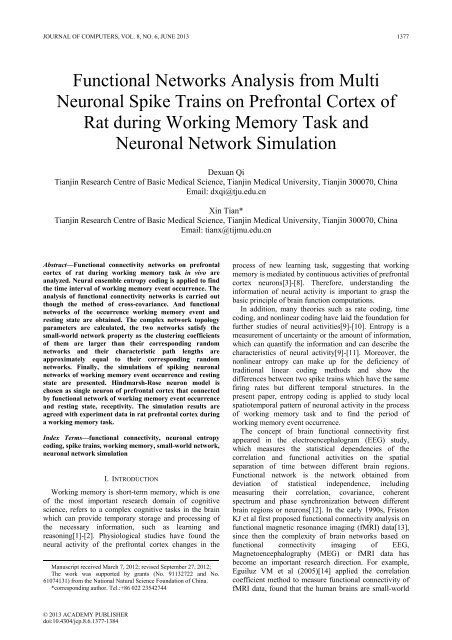Download Full Issue in PDF - Academy Publisher
Download Full Issue in PDF - Academy Publisher
Download Full Issue in PDF - Academy Publisher
You also want an ePaper? Increase the reach of your titles
YUMPU automatically turns print PDFs into web optimized ePapers that Google loves.
JOURNAL OF COMPUTERS, VOL. 8, NO. 6, JUNE 2013 1377<br />
Functional Networks Analysis from Multi<br />
Neuronal Spike Tra<strong>in</strong>s on Prefrontal Cortex of<br />
Rat dur<strong>in</strong>g Work<strong>in</strong>g Memory Task and<br />
Neuronal Network Simulation<br />
Dexuan Qi<br />
Tianj<strong>in</strong> Research Centre of Basic Medical Science, Tianj<strong>in</strong> Medical University, Tianj<strong>in</strong> 300070, Ch<strong>in</strong>a<br />
Email: dxqi@tju.edu.cn<br />
X<strong>in</strong> Tian*<br />
Tianj<strong>in</strong> Research Centre of Basic Medical Science, Tianj<strong>in</strong> Medical University, Tianj<strong>in</strong> 300070, Ch<strong>in</strong>a<br />
Email: tianx@tijmu.edu.cn<br />
Abstract—Functional connectivity networks on prefrontal<br />
cortex of rat dur<strong>in</strong>g work<strong>in</strong>g memory task <strong>in</strong> vivo are<br />
analyzed. Neural ensemble entropy cod<strong>in</strong>g is applied to f<strong>in</strong>d<br />
the time <strong>in</strong>terval of work<strong>in</strong>g memory event occurrence. The<br />
analysis of functional connectivity networks is carried out<br />
though the method of cross-covariance. And functional<br />
networks of the occurrence work<strong>in</strong>g memory event and<br />
rest<strong>in</strong>g state are obta<strong>in</strong>ed. The complex network topology<br />
parameters are calculated, the two networks satisfy the<br />
small-world network property as the cluster<strong>in</strong>g coefficients<br />
of them are larger than their correspond<strong>in</strong>g random<br />
networks and their characteristic path lengths are<br />
approximately equal to their correspond<strong>in</strong>g random<br />
networks. F<strong>in</strong>ally, the simulations of spik<strong>in</strong>g neuronal<br />
networks of work<strong>in</strong>g memory event occurrence and rest<strong>in</strong>g<br />
state are presented. H<strong>in</strong>dmarsh-Rose neuron model is<br />
chosen as s<strong>in</strong>gle neuron of prefrontal cortex that connected<br />
by functional network of work<strong>in</strong>g memory event occurrence<br />
and rest<strong>in</strong>g state, receptivity. The simulation results are<br />
agreed with experiment data <strong>in</strong> rat prefrontal cortex dur<strong>in</strong>g<br />
a work<strong>in</strong>g memory task.<br />
Index Terms—functional connectivity, neuronal entropy<br />
cod<strong>in</strong>g, spike tra<strong>in</strong>s, work<strong>in</strong>g memory, small-world network,<br />
neuronal network simulation<br />
I. INTRODUCTION<br />
Work<strong>in</strong>g memory is short-term memory, which is one<br />
of the most important research doma<strong>in</strong> of cognitive<br />
science, refers to a complex cognitive tasks <strong>in</strong> the bra<strong>in</strong><br />
which can provide temporary storage and process<strong>in</strong>g of<br />
the necessary <strong>in</strong>formation, such as learn<strong>in</strong>g and<br />
reason<strong>in</strong>g[1]-[2]. Physiological studies have found the<br />
neural activity of the prefrontal cortex changes <strong>in</strong> the<br />
Manuscript received March 7, 2012; revised September 27, 2012;<br />
The work was supported by grants (No. 91132722 and No.<br />
61074131) from the National Natural Science Foundation of Ch<strong>in</strong>a.<br />
*correspond<strong>in</strong>g author. Tel.:+86 022 23542744<br />
process of new learn<strong>in</strong>g task, suggest<strong>in</strong>g that work<strong>in</strong>g<br />
memory is mediated by cont<strong>in</strong>uous activities of prefrontal<br />
cortex neurons[3]-[8]. Therefore, understand<strong>in</strong>g the<br />
<strong>in</strong>formation of neural activity is important to grasp the<br />
basic pr<strong>in</strong>ciple of bra<strong>in</strong> function computations.<br />
In addition, many theories such as rate cod<strong>in</strong>g, time<br />
cod<strong>in</strong>g, and nonl<strong>in</strong>ear cod<strong>in</strong>g have laid the foundation for<br />
further studies of neural activities[9]-[10]. Entropy is a<br />
measurement of uncerta<strong>in</strong>ty or the amount of <strong>in</strong>formation,<br />
which can quantify the <strong>in</strong>formation and can describe the<br />
characteristics of neural activity[9]-[11]. Moreover, the<br />
nonl<strong>in</strong>ear entropy can make up for the deficiency of<br />
traditional l<strong>in</strong>ear cod<strong>in</strong>g methods and show the<br />
differences between two spike tra<strong>in</strong>s which have the same<br />
fir<strong>in</strong>g rates but different temporal structures. In the<br />
present paper, entropy cod<strong>in</strong>g is applied to study local<br />
spatiotemporal pattern of neuronal activity <strong>in</strong> the process<br />
of work<strong>in</strong>g memory task and to f<strong>in</strong>d the period of<br />
work<strong>in</strong>g memory event occurrence.<br />
The concept of bra<strong>in</strong> functional connectivity first<br />
appeared <strong>in</strong> the electroencephalogram (EEG) study,<br />
which measures the statistical dependencies of the<br />
correlation and functional activities on the spatial<br />
separation of time between different bra<strong>in</strong> regions.<br />
Functional network is the network obta<strong>in</strong>ed from<br />
deviation of statistical <strong>in</strong>dependence, <strong>in</strong>clud<strong>in</strong>g<br />
measur<strong>in</strong>g their correlation, covariance, coherent<br />
spectrum and phase synchronization between different<br />
bra<strong>in</strong> regions or neurons[12]. In the early 1990s, Friston<br />
KJ et al first proposed functional connectivity analysis on<br />
functional magnetic resonance imag<strong>in</strong>g (fMRI) data[13],<br />
s<strong>in</strong>ce then the complexity of bra<strong>in</strong> networks based on<br />
functional connectivity imag<strong>in</strong>g of EEG,<br />
Magnetoencephalography (MEG) or fMRI data has<br />
become an important research direction. For example,<br />
Eguiluz VM et al (2005)[14] applied the correlation<br />
coefficient method to measure functional connectivity of<br />
fMRI data, found that the human bra<strong>in</strong>s are small-world<br />
© 2013 ACADEMY PUBLISHER<br />
doi:10.4304/jcp.8.6.1377-1384
















